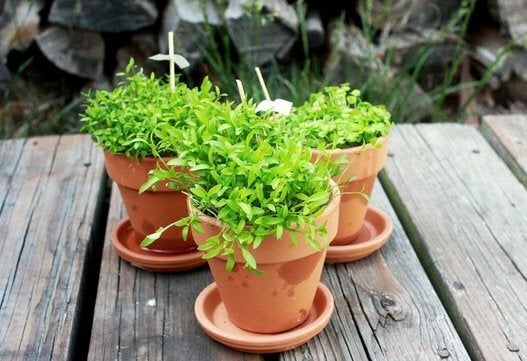
Injecting colour into the landscape doesn’t have to be difficult or a budget-buster — and colour can come from a variety of sources. In furniture, garden art, paint, pots, tile and, of course, plants, the impact colour has on the landscape cannot be understated. Here are 12 simple ways that you can add refreshing hues outside.
1. Select colourful outdoor furniture. Sitting areas and tables often serve as focal points in the landscape, which makes them great places to add colour. As a less expensive option, trade in tan and brown cushions for new ones in eye-catching colours or add pillows to your existing seat cushion.
2. Bring in colourful pots. One of the easiest ways to create a more colourful garden is to incorporate containers in shades of blue, magenta, orange, purple or even red. This is an opportunity to create a striking colour variation. Here you can see the dramatic contrast of orange marigolds in a blue or purple pot.
Pairing colourful containers with plants prized for their foliage, such as herbs, hostas (Hosta spp.) and succulents, is another easy way to create vibrant interest in the landscape. Planters can also provide badly needed colour in a shady front entry where flowers won’t grow but a nice green shade-loving plant will.
3. Add an outdoor rug to your deck or patio. Don’t overlook the opportunity to add interest at ground level by bringing in a rug with a pleasing design in shades that will enhance your outdoor dining or seating areas.
4. Paint a wall in an eye-catching colour. A can of paint and a couple of hours are all it takes to infuse the landscape with a rich hue. Paint an exterior or garden wall for a dramatic difference.
Here we see common sotol (Dasylirion wheeleri) and Santa Rita prickly pear (Opuntia santa-rita) planted in front of a colourful wall.
When selecting a paint colour, choose one that will complement the surrounding area, including outdoor furniture and plants. A colour wheel can help you decide whether to go with a complementary or analogous colour.
While some homeowners associations don’t allow brightly coloured walls on building exteriors, you may be able to paint parts of the landscape not visible from the road.
5. Incorporate decorative tiles. Tile comes in many different colours and designs, which makes it a great material to add colour to outdoor structures such as stairs, kitchen countertops or water features, or it can be used to create a mural.
6. Use colourful outdoor decor. Garden art can handle the weather extremes of the outdoors while adding interest to the landscape. Examples include colourful steppingstones, mosaic art and the popular Talavera pottery, to name just a few.
7. Brighten up a bare wall with a mural. This is an especially helpful tip if space is limited, as a mural takes up no ground space and adds both colour and interest to an outdoor wall. Whether you add plants to the landscape by painting them on the wall or create the illusion of a framed piece of art, a mural can be a great way to dress up the outdoors.
8. Decorate the outdoors with colourful, flower-filled pots. Another one of the easiest and most fulfilling ways to add colour to the outdoors is to incorporate flowering plants in containers. These miniature gardens not only beautify their surroundings, but they can also be moved to other locations and changed out seasonally to whatever suits you at a given time.
Hanging flower baskets add colour at a higher level and can be used to frame a view from a window.
9. Add colour toward an entry with flowering plants. A group of flowering plants draws the eye toward an entry — and can also increase curb appeal. You can do this by adding pots filled with flowering annuals or creating a bed filled with blooming plants in the front yard. In this garden, a raised bed has been created out of a retaining wall and filled with pink geraniums.
Flowering perennials add colour to entries in arid gardens. Angelita daisy (Tetraneuris acaulis) and Parry’s penstemon (Penstemon parryi) planted next to a boulder help to create a colourful entry here.
10. Add flowers to your vegetable beds. Plant cosmos, marigolds and nasturtiums in with your vegetables. Seasonal favorites such as sweet alyssum, lobelia, petunias and violas also do well in vegetable gardens. They not only add lovely colour but attract pollinators.
Nasturtiums bloom among vegetables like tomatoes, peppers and broccoli in this East Coast garden.
11. Look beyond flowers to plants with vibrant foliage. Colourful foliage isn’t limited to fall. Many plants provide year-round colour other than green through their foliage for dramatic interest long after the flowers have faded. Here, a Florida landscape comes to life with the magenta leaves of tiplant (Cordyline fruticosa) and a purple wall.
12. Look for new areas to add colour. Take a few minutes to walk through your garden and try to see it through a different set of eyes — you can also ask a friend to do this for you. You may discover a new area to add plants.
More on Houzz
Also on HuffPost
